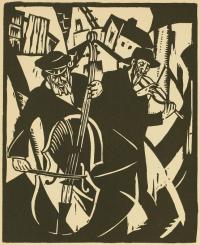Yiddish & Ashkenazic Studies

Yiddish Studies
- Resources and Funding
Questions? Please contact Professor Zaritt (.1), our Director of Yiddish Studies.
Yiddish at Ohio State
Courses in Yiddish language, literature, and culture have been offered at The Ohio State University since 1978. Students can learn about the Yiddish-speaking world from a wide variety of perspectives.
What Yiddish Language and Culture classes can I take?
- Yiddish 3399: Holocaust in Yiddish and Ashkenazic Literature and Film / GE Theme: Citizenship for a Just and Diverse World *4-credit course; Integrative Practice: Research and Creative Inquiry.
- Yiddish 2241: Yiddish Culture / GE Foundation: Historical and Cultural Studies
- Yiddish 2241 focuses on German-Jewish and Yiddish television and other media!
- Yiddish 3371: Yiddish Literature in Translation (not currently offered)
- Yiddish language classes: 1101 / 1102 / 1103
- Yiddish 1101 will be offered in person every autumn semester; 1102 & 1103 will be offered on a regular basis either in person or via BTAA CourseShare.
- Students can fulfill their GE Language requirements with Yiddish!
- and Yiddish 5671: Yiddish for Speakers of German
Questions? Please contact Professor Zaritt (.1), our Director of Yiddish Studies.

Yiddish as Part of a Major or Minor
Most Yiddish classes can count toward a major or minor in Jewish Studies, which is run through the Department of Near Eastern and South Asian Languages and Cultures (NESA).
Contact Tommy Beyl (.1), the Advisor for Jewish Studies, for more information.
Some Yiddish classes may also count as elective credits toward other majors and minors, such as German, History, and Slavic and East European Languages and Cultures. Talk with your departmental advisor to see if such classes can count in your case.
Yiddish for Graduate Students
Graduate students interested in learning Yiddish for research purposes are encouraged to take “Yiddish for German Speakers” (usually offered in the spring, focused on reading and research skills) or to enroll in the standard language course sequence.
- Graduate students are often eligible to apply for FLAS or for select scholarships offered by the Melton Center for summer language study.
- Independent study on select Yiddish-related topics may also be possible depending on availability. As an example, two graduate students in English completed an independent study on the history of modern Yiddish poetry in SP23.

Resources and Funding at Ohio State
- Melton Center for Jewish Studies
- Jewish Studies Library Resources
- Fraydele Oysher Yiddish Theatre Collection
Funding for Yiddish Study
Undergraduate and graduate students can apply for a FLAS award for Yiddish language and area studies during the academic year or the summer. FLAS awards are coordinated through the Center for Slavic, East European and Eurasian Studies. Yiddish is currently eligible for FLAS funding by petition. Yiddish students may also be eligible to apply for funding from the Polish Studies Initiative. For more information, see the Slavic Center website.
Up to $3,000 is also available each academic year to help cover the costs of an approved Yiddish study abroad program via the George and Emily Severinghaus Beck Education Abroad Scholarship. This scholarship is run through the Melton Center for Jewish Studies.
At present, there are excellent Yiddish summer programs at Tel Aviv University, the Medem Library in Paris (sometimes hosted in Berlin), the L’Institut d’Etudes du Judaïsme in Brussels, and the Shalom Foundation and the Center for Yiddish Culture in Warsaw. There are also excellent programs in New York City and Amherst, Massachusetts, though these programs cannot be covered by a study abroad scholarship (they may, however, be covered by FLAS or other kinds of funding).
History of Yiddish
For roughly a thousand years, Yiddish was the shared vernacular of Ashkenazic (Eastern and Central European) Jews. Yiddish was, for much of its history, truly global in reach, with active cultural and social centers in Warsaw, Kiev, Vilnius, Birobidzhan, Moscow, Berlin, Vienna, New York, Chicago, Montreal, Buenos Aires, Johannesburg, and London, among other locations. Yiddish newspapers were even published, for a time, in Ohio!
In the wake of the Holocaust and widespread linguistic acculturation, Yiddish lost the majority of its speakers. However, upwards of a million people worldwide continue to speak Yiddish as their mother tongue, especially in Hasidic and Haredi (‘ultra-Orthodox’) communities in the United States, Israel/Palestine, and Europe. In recent years, the number of Yiddish speakers has been growing, not shrinking.
As a minority language and a fusion language that synthesizes multiple components, including Germanic, Slavic, Hebrew, and Aramaic components, students interested in a wide range of linguistic, sociocultural, and historical topics may find Yiddish to be an exciting and multifaceted research language.
As one of the most widely spoken Jewish languages, with a rich tradition of literature, music, politics, and religious practice, Yiddish might be of interest to students pursuing Jewish Studies, Linguistics, History, Germanic Languages and Literatures, English, Slavic and East European Languages and Cultures, Religion, International Affairs, Political Science, Dance, Music, or Theatre, Film, and Media Arts, among other majors. Yiddish is, moreover, an essential tool if you are interested in the history of Jewish culture, politics, and society in Eastern and Central Europe, in the study of Jewish migration to the United States, in the history of Jewish women’s religious practices, in the development of Hasidism, or in the history of the Holocaust, among numerous other topics.
